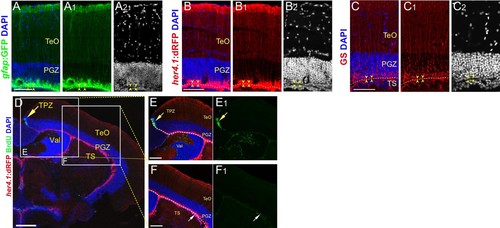Fig. 1-S1
- ID
- ZDB-FIG-191014-14
- Publication
- Yu et al., 2019 - Stochastic cell-cycle entry and cell-state-dependent fate outputs of injury-reactivated tectal radial glia in zebrafish
- Other Figures
- All Figure Page
- Back to All Figure Page
|
Injury responses of RG in different geographical regions in the optic tectum.(A–B2) Representative images of Tg(gfap:GFP) (green) and BrdU (red) immunofluorescences showing RG underneath the injury site enter the S phase at 3 dpi. After the injury, the fish are administrated with BrdU for 1 day (2-3dpi) and analyzed at 3 dpi. (B–B2) The high-magnification images of boxed area shown in (A). White arrowheads (in B-B2) indicate the BrdU+/GFP+ RG underneath the injury site. (C) Quantification of BrdU+ RG in (A–B3) showing 30 ± 4 RG enter the S phase. (mean ± SEM, ***p<0.001; Wilcoxon test). (D) Experimental time courses of Cre-loxP-based single RG genetic labeling shown in (E). Double transgenic fish are administrated with tamoxifen (TAM) for three consecutive days and analyzed at day 8, before sacrifice the fish are heat shocked for 3 times (one hour per day) to induce EGFP expression in recombined cells. (E) Representative image of sparsely labeled tectal RG (EGFP+ green cells, white arrows) at day 8. (F–O) Representative images of PCNA (red) immunofluorescence showing injury induces proliferation of RG underneath the injury site at 3 dpi in different regions of optic tecta. (K–O) The high-magnification images of boxed area in (F–J). (P) Quantification of PCNA+ cells in (F–O). Across the five regions, only the RG in the medial-dorsal region shows low proliferation capacity after injury (mean ± SEM; **p<0.01; ns, p>0.05; one-way ANOVA followed by Tukey’s HSD test). (Q–S) Representative images of PCNA (red) and GS (green) immunofluorescences showing that injury induces less proliferation of RG (white arrowhead in (R)) in the medial-dorsal region compared with the RG (white arrowheads in (S)) in the central-dorsal region of a two-sites injured optic tectum. (R and S) The high-magnification images of boxed areas in (Q). (T) Quantification of PCNA+/GS+ RG in (R and S). Injury induces significant more RG proliferation in the central-dorsal region than in the medial-dorsal region (mean ± SEM, **p<0.01; Wilcoxon test). The numbers above the bars indicate the animals used. White dashed lines indicate the boundary of the tectal ventricle. Yellow arrowheads indicate the injury sites. A, anterior; P, posterior; D, dorsal; V, ventral; L, lateral; Tel, telencephalon; OT, optic tectum; Ce, cerebellum; SC, spinal cord; RG, radial glia; TeO, tectal opticum; PGZ, periventricular gray zone; TS, torus semicircularis; Val, valvula cerebelli. Scale bars, 100 μm (F–J and Q); 50 μm (A and E); 30 μm (F–J); 20 μm (K–O); and 10 μm (R and S). |

